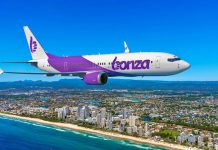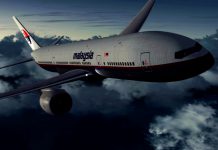Ships and planes searching for Malaysia Airlines flight MH370, missing for 30 days, were redirected Sunday April 6th to verify a promising acoustic event detected by the Chinese search ship Haixun 01.
Speaking at the Joint Agency Coordination Centre Air Chief Marshall Angus Houston (Ret’d) also confirmed that the Australian ship Ocean Shield had detected an acoustic signal about 400km from the Chinese contact.
The Haixun 01 recorded the signal, used by aircraft black boxes, for only 90 seconds on Friday and again on Saturday evening.
A Chinese search plane also sighted a number of white objects about 90km from where the ping was detected.
However ACM Houston urged caution and said that the signals, while “promising,” had not been verified.
The Chinese picked up the signal, on the frequency of 37.5kHz, using a hand held $16,000 Teledyne sonar locator deployed from one of the ships lifeboats.
According to Justin E. Manley, senior director of business operations for Teledyne Benthos the handheld pinger locating devices were first built for scuba use.
Mr Manley told CNN that “holding the device over the side of a vessel may not be the best option, but it should work.”
The handheld hydrophone used by Chinese is vastly different from the US Navy towed pinger locator deployed on Ocean Shield. The towed pinger locator can glide along near the bottom of the ocean sea and is more sensitive and has a far greater detection range according to Tom Altshuler, vice president and group general manager for Teledyne Marine Systems. “One is designed to find a pinger in deep water, the other is designed to find a pinger in shallow water,” Mr Altshuler told CNN.
And according to the black box beacon manufacturer there is not much doubt about the signal being from the black boxes.
Anish Patel, president of Dukane Seacom told CNN that the frequency chosen for use in the recorders gives “standout quality that does not get interfered with by the background noise that readily occurs in the ocean.”
HMS Echo was redirected to the area and is expected to be on station Monday April 7th. The hydrographical survey ship is equipped with a suite of sonar detection equipment.
Ocean Shield is investigating another “acoustic event” in a separate area, which had only been detected in the hour before ACM Houston held the press conference. It will be redirected depending upon the outcome of its search.
ACM Houston also advised that there had been a slight difference in the calculated air speed of MH370, which indicated the Malaysia Airlines 777, with 239 passengers and crew, may have been going faster than first thought.
This meant that the search area would be more focused in the southern reaches of the current search zone, but did not change the overall search area.
ACM Houston said that the ocean in the Chinese search area was 4.3km deep, so any recovery operation would be demanding and take a long time.























